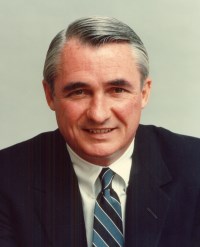Obituary: John Akers, the IBM CEO who lost the PC market

John Fellows Akers, who joined IBM in 1960 after serving in the US Navy as a jet pilot and rose to CEO and president, died on August 22 in Boston aged 79. He received 16 promotions in 23 years, becoming president in 1982 and chief executive in 1985, before retiring in 1993.

Akers was very successful during the mainframe era, when IBM became the world's most powerful corporation following the launch of the S/360 range of mainframes in 1964. In some years, IBM made around 70 percent of the IT industry's turnover, and more than 100 percent of its profits.
However, under Akers, IBM lost the PC market. IBM's pragmatic use of Intel and Microsoft products in the IBM PC, launched in 1981, enabled these upstarts to dominate the first decades of the PC business. (Intel wasn't powerful at the time, and Microsoft was tiny, with around 40 staff.)
IBM tried to recover from what it saw as an error, and tried to throttle Microsoft, without success. Its efforts included the PS/2 range of PCs, which gave IBM control over the expansion bus, the OS/2 operating system, and SAA (Systems Application Architecture).
While OS/2 was initially co-developed with Microsoft, the success of Windows 3 created problems. In the early 1990s, the companies went through a highly publicised divorce over its future.
IBM was still an enormous, paternalistic company with a lifetime employment policy, but Akers tried to slim it down. IBM introduced a Career Transition Program (CTP), known internally as "Cash to Piss off".
Akers was pressured to step down after IBM reported the biggest annual loss in its history, and its share price collapsed. At the time, he was planning to split up the company — known as Big Blue — into a collection of Baby Blues that would be able to move quicker. However, Akers' replacement, Lou Gerstner, dropped that plan, dumped OS/2, shed more than 100,000 employees, and transformed the company.
Gerstner was the first outsider to run IBM. He had been a large IBM customer at RJR Nabisco and American Express, and he started by having a Year of the Customer at IBM. However, IBM management reverted to type after Gerstner retired.
In the feudal IBM management system, progress and senior promotions depended to a large extent on which high-flying exec's coattails you became attached to, or managed to grab hold of. Akers had been Frank Cary's executive assistant when he was a senior vice president, and benefited when Cary became CEO. (Cary had been former-CEO Vin Learson's man, and Learson had been Tom Watson Jr's man. Tom was the son of IBM's founder.) The last but one CEO, Samuel J. Palmisano, had been one of Akers’ executive assistants, before passing the baton to Virginia Rometty, the current CEO.
Akers was born in Boston on December 28, 1934, and earned a business degree from Yale in 1956. At Yale, he'd been an all-Ivy League hockey player, and after graduating, he joined the US Navy and became a carrier pilot. On leaving the navy, he joined IBM as a salesman, so all his experience was in very large, bureaucratic organizations. It probably wasn't the best background for coping with the PC world from 1981-93, when microcomputers were starting to disrupt the minicomputer and mainframe industries.
Akers remained a smartly-dressed, rock-jawed and somewhat imposing figure, though he reminded at least one outsider (me) of a tailor's dummy. In those days, IBM presidents and CEOs fraternised with US presidents and other heads of state, to which they had similar economic power. To the rest of us, they seemed remote and unapproachable figures.
IBM's obituary quotes a 2010 interview where he said: "We were very square. We wore the blue suits, white shirts with button-down collars, striped ties, fedoras and wingtip shoes." As IBM notes, "That image came to stand for something: 'The customers felt they could count on us.'"
It's an age that hasn't quite gone. IBM currently makes $100bn a year — it's still much larger than Intel or Microsoft — and it still dominates data processing in Fortune 500 companies. That's a legacy from the Watsons, Learson, Cary, Akers and many others. But they still lost the PC business.
The computer world might be a different place if IBM had dominated microcomputing the way it dominated the mini and mainframe markets. It would probably be much worse. Akers is worth cherishing not for his successes at IBM, but for his most notable failure.